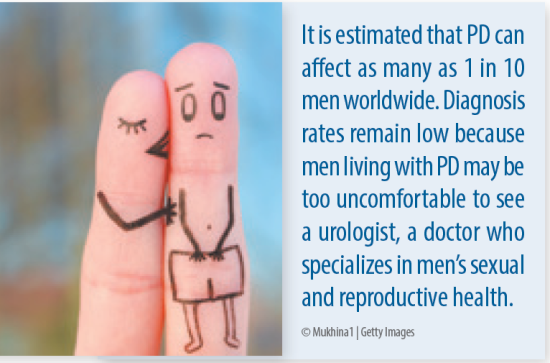Peyronie’s Disease, Curves Ahead
Peyronie’s disease (PD) affects about one in 10 men, mostly at middle age, but older men can be affected, too. The disease is characterized by an abnormal bend in the penis, typically caused by some kind of trauma. While a bit of curvature is normal, in some men with PD the curve becomes excessive and troublesome. For example, they may shun intimacy, experience pain during erection, and penetration may be difficult, if not impossible. While only about 10 percent of men are estimated to have PD, most experts believe it’s underreported due to men’s general reluctance to discuss such matters.
Bent Out of Shape
Micro-injuries to the penis, such as from prostate surgery, sports injury, repetitive traumas, and extremely vigorous sexual penetration, can cause inflammation and result in a buildup of fibrous scar tissue called plaque. Researchers report that many men are unable to recall a specific event or injury that caused the problem. The damage can occur from small repetitive actions or a single injury. There also may be a genetic component, as the disease tends to run in families. Men with diabetes-associated erectile dysfunction (ED) and connective tissue and autoimmune disorders are at greater risk for developing PD. Age-related tissue changes in the penis also may make it more vulnerable to injury and less likely to heal properly. Unlike cholesterol plaque that forms in blood vessels, PD plaque builds up in the thick elastic membrane called the tunica albuginea. This membrane keeps the penis stiff during erection. Upon arousal, the plaque pulls on the surrounding tissues, causing the bend that often results in physical pain and other problems. “Peyronie’s disease has a significant psychological impact on men,” says urologist Jesse Mills, director of The Men’s Clinic at UCLA. “Our clinic is collaborating with Swedish colleagues at Karolinska Institute on a longitudinal research project to investigate further. Our initial findings, recently published in the Journal of Urology, show that men with Peyronie’s have much higher rates of depression, severe mental health issues, and substance abuse. If a man is suffering from Peyronie’s, help is available.”

Symptoms and Disease Progression
The signs of PD may develop slowly or come on quickly and can be mild or severe. Typically, the pain subsides in time, but the excessive curve remains. Symptoms include:
- hard lumps on one or more sides of the penis
- pain during sexual intercourse or during an erection
- a curve in the penis with or without an erection
- changes in the shape of the penis, such as narrowing or shortening
PD has two distinct phases: acute and chronic. During the acute phase, inflammation triggers scar tissue to form. The penis begins to curve, and pain may be present without an erection. This initial phase lasts about 18 months. The disease is considered in its chronic phase when the plaque and curve have stabilized, and pain generally decreases. ED may develop or worsen.
Treatment Options
Not every man requires treatment. The degree of curve may not be significant enough to interfere with intercourse and it may not cause pain. Also, the disease is not fatal, and for some men, PD goes away without treatment, though this is rare.
For those who require treatment, Medicare typically covers it. According to Dr. Mills, vacuum erection devices don’t help with PD, but may help with ED. Penile traction stretches tissue and does have data to supportive its effectiveness, especially when it’s used with the only FDA-approved injectable treatment for PD, Xiaflex (an enzyme that dissolves plaque). It’s injected directly into the penis and is understandably daunting, but a highly-skilled urologist can perform the procedure in less than a minute. Practitioner technique is everything.
“Xiaflex works well in all ages, and the typical course is eight injections over about five months,” says Dr. Mills. “Men over age 70 should also pay attention to the strength of their erections. I like to treat Peyronie’s and ED simultaneously to optimize outcomes.”
Surgery is another possible treatment, but it’s a last resort. “To come up with the right therapy, it’s crucial to consider all aspects of a person, from cardiovascular health, to hormonal levels to degree of sexual dysfunction impairment,” he says.
While the curve caused by PD may not be completely corrected, according to Dr. Mills most men are satisfied with minimally invasive treatments. For more details about PD and treatment options, watch Dr. Mills’ excellent video at http://tiny.cc/PDMills.
The post Peyronie’s Disease, Curves Ahead appeared first on University Health News.

